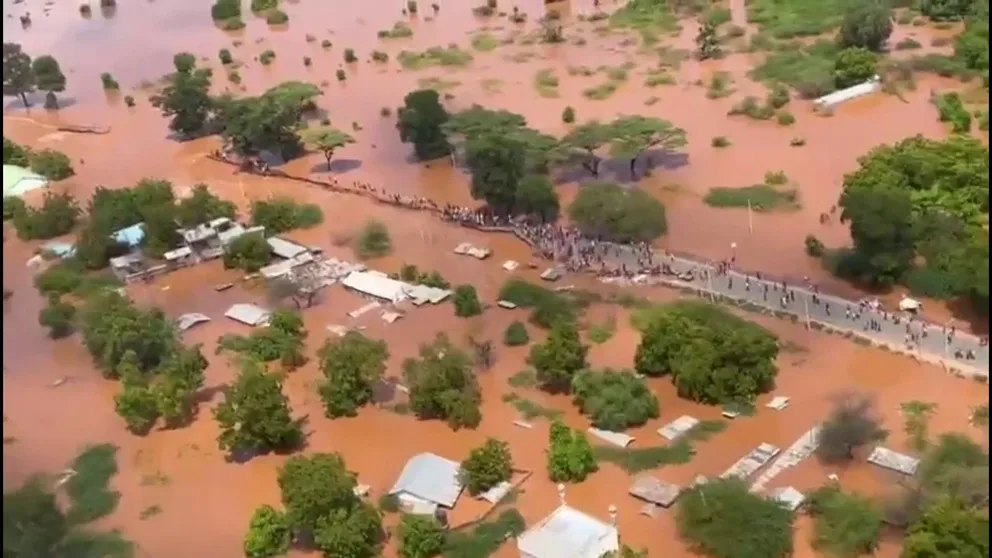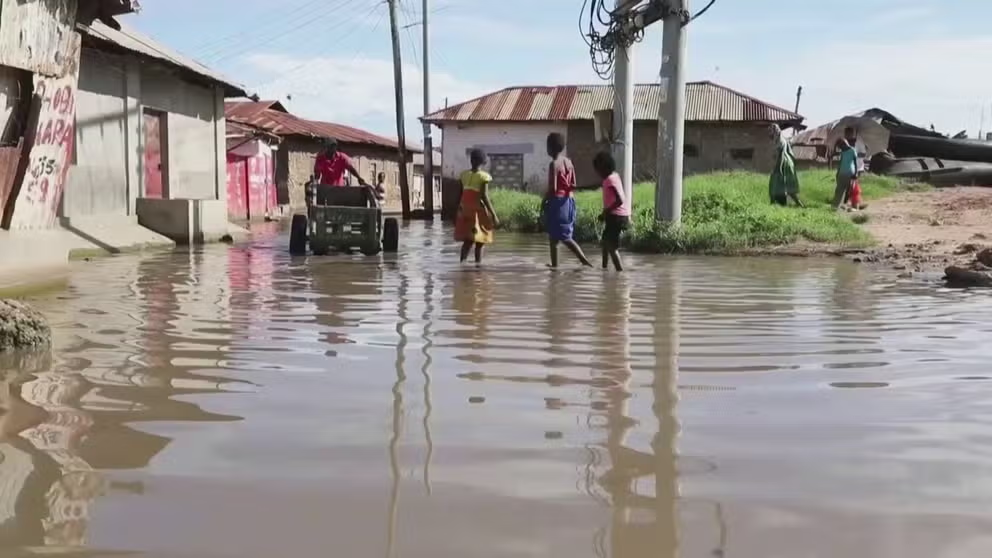Disease outbreak threatens Kenya after deadly flooding cripples region
Over half a million Kenyans are struggling with flooding that already killed over 130 people. Now, survivors are battling cholera, malaria and diarrhea.
Kenyans flock to roadway, only surface above water in floods
Kenya's Secretary General took video as he toured flood-ravaged Garissa. Much of Kenya is underwater after El Niño storms flooded villages. Residents gather on the roadway, one of the only surfaces still above water.
The 90,000 families forced from their homes by flooding are now struggling with an outbreak of water and vector (mosquito) borne disease. Over half a million Kenyans are affected by flooding on the heels of "the worst drought in 40 years," according to a government spokesperson.
"The situation in these counties has led to an increase in disease outbreaks such as cholera, malaria and diarrhea," the spokesperson said in a statement.
The Ministry of Health announced they have only limited contact with flooded regions. Even so, staff already confirmed almost 391 cases of diarrhea (the pathogens are water-borne), almost 100 of cholera and suspect nearly 550 are sickened by malaria (mosquito-borne).
DEATH TOLL CONTINUES TO RISE IN AFRICA AFTER FLOODING CRIPPLES COMMUNITIES
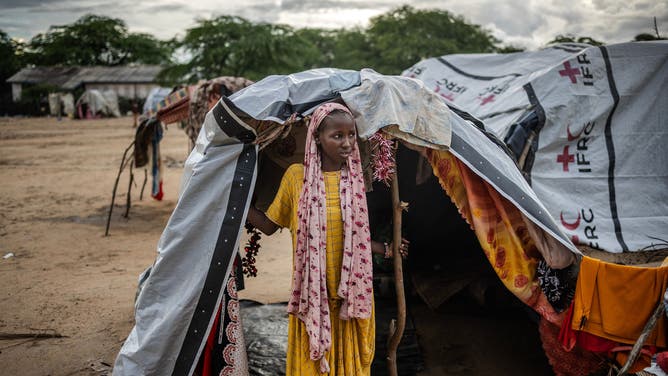
Najuma Abdi, whose house was destroyed by flash floods, stands at the tent where she lives with her family at an internally displaced persons (IDP) camp for families displaced by floods in Garissa on November 20, 2023.
(LUIS TATO / AFP / Getty Images)
The World Health Organization delivered health kits to two counties in the past day to try to contain the cholera and diarrheal outbreaks, announced the National Disaster Operations Centre.
Roads washed out, communities isolated
Many roads are still impassible, as seen in the video above. Emergency responders and aid workers can't even enter many villages marooned by high water and washed-out roads. In Garissa, villagers flock to what is left of the elevated roadway because their homes are in water.
"Our house is now unlivable, so we have to sleep somewhere else," a mother in Mombasa told China Central Television. "We need medicine, blankets and food for the children. We have no place to stay, and the children had to stay in others' houses."
7 FACTS YOU SHOULD KNOW ABOUT FLASH FLOODS
Floods overtake Kenya, now disease outbreak
The survivors in Mombasa, Kenya have a new struggle almost two months into deadly flooding and thunderstorms killed more than 130 people. Rains continue to fall and now victims are battling an outbreak of diarrhea, malaria and cholera.
One road finally reopened mid-week, where 36 trucks had been stuck for over three weeks, the Minister of the Interior said in a statement. Over 11 tons of food was airlifted to one county on Wednesday alone.
So far, 136 Kenyans have died in the storms and flooding, up from 120 just yesterday, according to government ministers. Media reports earlier in the week placed the death toll in Somalia at 96 and 44 in Ethiopia.
National Emergency
The government set up the National El Niño Emergency and Disaster Response Centre this week. Spokespeople give daily updates. The center includes a multi-agency flood team to monitor flooding and warn at-risk communities. The group identified four counties as the worst hit, where they are delivering aid. Ten other counties are on "high alert."
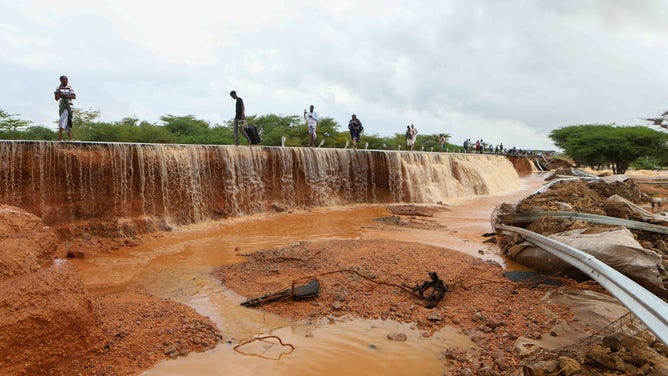
People walk along a destroyed road following heavy rains on Thika-Garissa highway in northern Kenya on Nov. 22, 2023.
(Joy Nabukewa/Xinhua / Getty Images)
Kenya alone has opened 118 displacement camps with meals for more than 3,300 households and 16,670 people. Unfortunately, even the camps are flooded. In Mombasa, widespread areas received 7.8 to 11.8 inches of rain in the semi-arid country.
"Disruptions in flood-affected areas will likely continue for some time as response and recovery operations are ongoing," said spokesperson Isaac Mwaura in a statement. "The rising levels of our dams also warrants caution, and residents are advised to move to higher ground as the National Government Administrative Officers liaise with County Governments to establish temporary shelters."
The government sent additional boats to flooded areas to help evacuate stranded villagers. The meteorology office warns the excessively wet pattern will continue through the winter.
EL NINO'S ODDS FOR ‘HISTORICALLY STRONG’ EVENT INCREASE; COULD LINGER THROUGH SPRING

A girl jumps a rope while playing with friends at an internally displaced persons (IDP) camp for families displaced by floods in Garissa on November 20, 2023.
(LUIS TATO/AFP)
What caused the floods
"Overall, we have now roughly over 650,000 people displaced and 1.4 or 1.5 million people - to be very honest, nobody really knows the concrete figures - are going to be affected. That is now but, we have currently a confluence still of the Indian Ocean dipole of El Nino, we have a cyclone building up in the Indian Ocean, we have rains continuing in the highlands of Ethiopia," said Pascal Cuttat, head of the International Red Cross Committee to Reuters about the entire Horn of Africa. "All of that means that this is not over, and it’s not yet at its peak. It’s getting worse, and these people are going to suffer more."
The Indian Ocean Dipole is another atmospheric event. El Nino and the positive dipole generally mean increased rainfall.
STRONG EL NINO WINTER: WHAT KIND OF WEATHER YOU CAN EXPECT
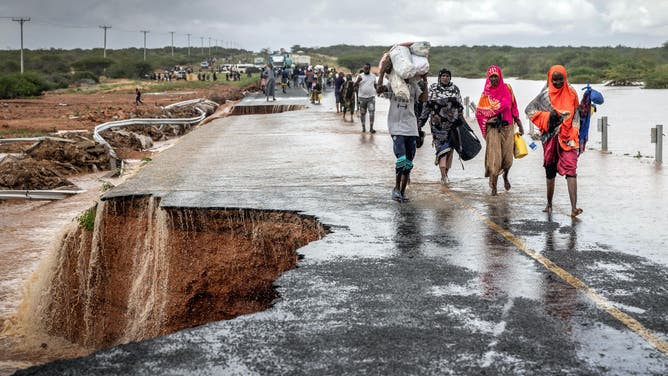
People carry their belongings while crossing the section of a road collapsing due to flash floods at the Mwingi-Garissa Road near Garissa on November 22, 2023.
(LUIS TATO/AFP / Getty Images)
"The Indian Ocean Dipole has two phases much like ENSO (El Nino Southern Occilation), a positive phase when sea-surface temperatures are above average in the Indian Ocean and a negative phase when sea-surface temperatures are below average in the Indian Ocean," explained FOX Weather Senior Weather Data Specialist, Shane Brown. "El Niño and the positive phase of the Indian Ocean Dipole tend to run in tandem, and that is indeed what we are seeing now."
The flooding is part of a series of tragic weather and climate events in Kenya. The United Nations reported that after five below-average rainy seasons. The reports said that 4.4 million people were in "crisis" and 1.2 million more were in "emergency." The drought killed 2.5 million livestock.
